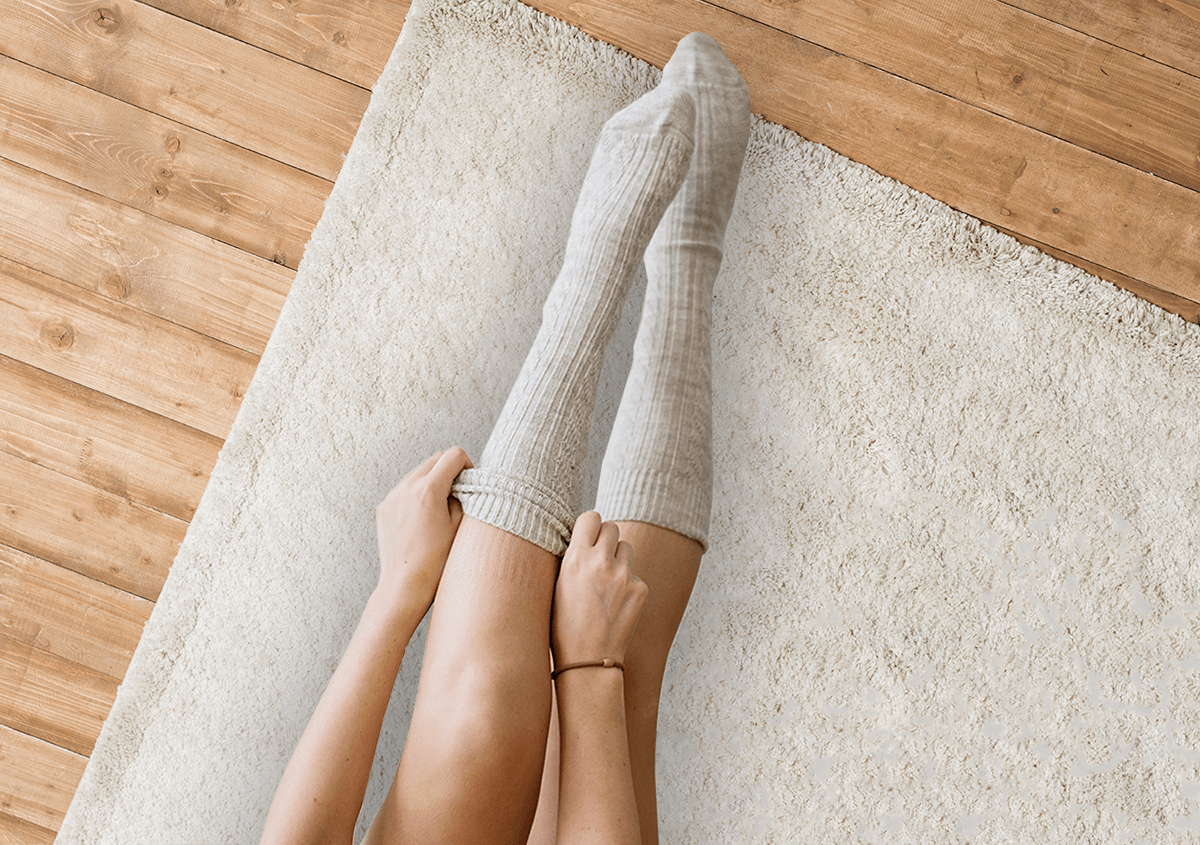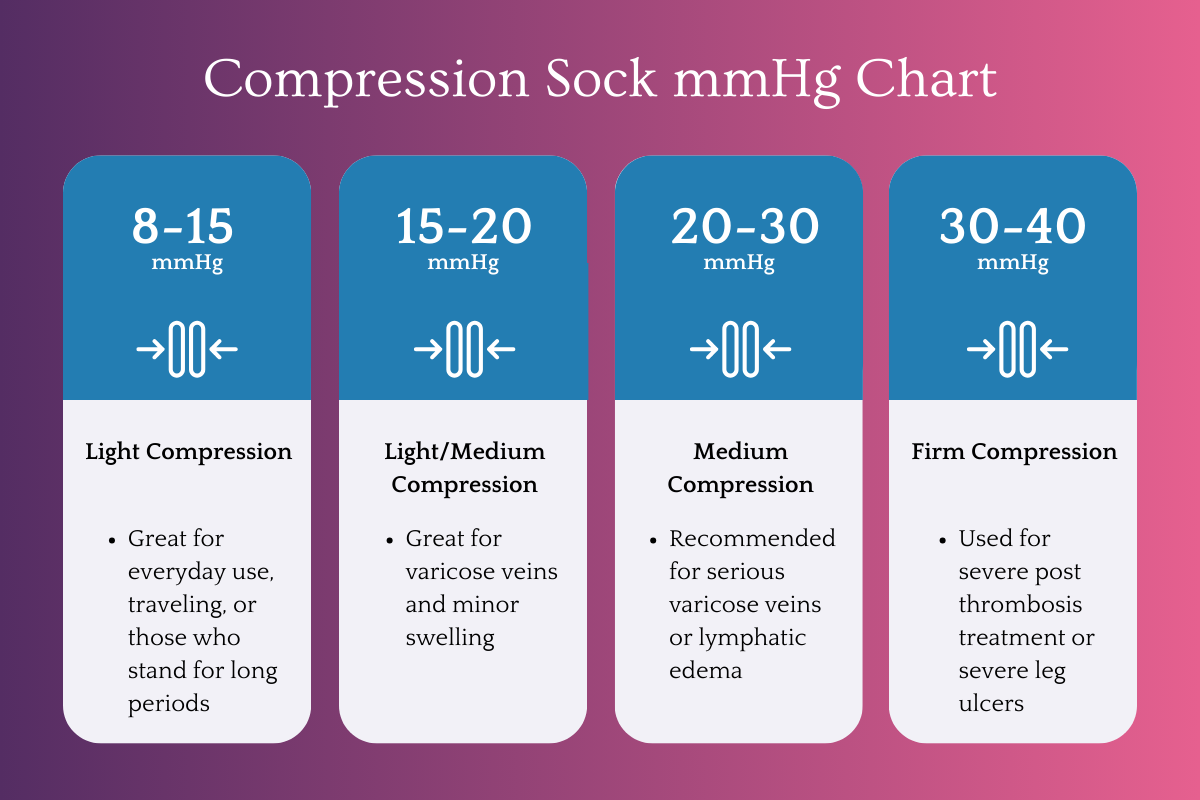
Compression socks, sometimes called compression stockings, are a specialized type of sock that can help improve many health conditions. They work by applying gentle pressure that is stronger at the ankles and gradually decreases as it moves up the leg. This pressure, consistently applied, improves blood flow and circulation to the heart and veins. Compression socks help reduce pain and swelling in the legs and ankles and can prevent blood clots by stopping blood from pooling in the legs. Health professionals recommend compression socks as a valuable aid for various medical conditions. However, there are many reasons to wear them and a wide range of types to choose from. This blog explores the various types of compression socks, the conditions where they are most effective and how to choose the right ones for your needs. Honest Medical (HonestMed) offers a full range of compression socks in multiple sizes, lengths and levels of firmness.
🧦 Benefits of Compression Socks
Compression socks offer many benefits for those with health conditions and for those who are active and like the extra support. Some of the benefits of wearing compression socks include the following:
- Compression Socks boost circulation and reduce swelling in legs and ankles
- They improve drainage of your lymphatic system, which also prevents pain and swelling
- They are helpful in managing the low blood pressure which can happen when you stand after sitting for long periods of time
- Compression socks prevent the blood from pooling in your leg veins which can cause dangerous blood clots, called deep vein thrombosis (DVT), a risk that increases significantly as you age
- They are used to treat venous leg ulcers by reducing swelling, aiding healing and preventing them from forming again
- They help reduce the pain caused by varicose veins
- Compression socks help control and reverse venous hypertension
🧦 Who Should Wear Compression Socks?
Those who pursue the following professions and activities can benefit from compression socks:
- Healthcare professionals such as nurses, doctors, surgeons, and physical therapists
- Athletes and fitness professionals like runners, cyclists, weightlifters, and gym instructors
- Service industry workers such as retail workers, hairdressers, food service workers, flight attendants and more
- Office workers with roles such as computer programmers, administrative assistants, customer service agents, front desk workers, and more
- Teachers and physical education coaches
Compression socks are a valuable health and wellness tool for a variety of individuals. They can be particularly beneficial for those experiencing:
- Circulatory issues such as varicose veins, DVT, or diabetes
- Fluid retention and swelling in your legs and ankles caused by lymphatic fluid retention (lymphedema)
- Post-surgery recovery to aid in healing and reduce swelling
- Immobility from being confined to a bed or wheelchair for extended periods
- Prolonged standing or sitting required by your job
- Athletic activities such as sports
- Pregnancy to manage swelling and discomfort
- Frequent travel such as long flights on planes or car rides
🧦 Choosing the Right Compression Socks
Compression socks come in a variety of sizes, lengths and pressure levels, depending on each person’s needs. Consult with your doctor for the right compression level before buying them. The pressure you choose will depend on your physical needs and the size of your legs. Compression stockings are measured in mmHg units. This scientific unit measures the pressure of fluids. A higher mmHg rating indicates more pressure.
Compression socks work by applying gentle pressure that is stronger at your ankles and becomes gradually lighter as it moves up your leg. As the pressure on the fluid in your legs (blood or lymph fluid) increases, it forces your blood and lymph fluids to flow more quickly – improving circulation and making it easier for your heart to get blood back through your veins to your legs.
Compression ranges from light compression (8-15 mmHg) to light/medium compression (15-20mmHg), to medium compression (20-30mmHg), to the highest level, firm compression (30-40mmHg). It is important to use the right level of compression, so if you have any questions about the range of firmness you should be using, consult your health professional.

The following are the different levels of compression and how they are typically used:
- Light compression socks are ideal for anyone who loves to run, hike, or pursue other physical activities and anyone whose job requires them to be on their feet for long periods. Mild compression socks are also ideal for air travel where ankles and feet can swell due to cabin pressure.
- Light/Medium compression socks are typically used for health issues such as varicose veins, or for people who experience minor swelling in their legs and feet. They also offer ideal support for pregnant women, anyone confined to a wheelchair, or office workers who sit at a desk all day.
- Medium compression socks are often recommended for more serious varicose veins, or to treat lymphatic edema, active ulcers or to heal and prevent DVT.
- Firm compression socks are used for more severe forms of post thrombosis treatment or for severe leg ulcers.
🧦 Compression Sock Sizing: Measuring Your Leg
There are different lengths of compression socks so be sure to get the length that best suits your needs. Ask your health professional if you have any questions about your measurements. If you want to measure the socks for yourself or a loved one, the following guidelines may help:
- First, measure your legs in the morning when they are likely to be the least swollen
- Ankle: Use a tape to measure around the narrowest part of your ankle – typically, just above the ankle bone
- Calf: Measure around the widest part of your calf, which is usually midway between your ankle and your knee
- Length: Sit in a chair with your feet flat on the floor and measure the length of your leg from your knee to the floor
- Thigh: If you need thigh-high stockings, measure around your thigh at the widest part
Once you have these measurements, you can compare them with the compression sock manufacturer’s size chart. This is important because different brands of socks may have different measurements for each size range.
💡 Tips When Using Compression Socks for the First Time
If this is your first time wearing compression socks, the following are a few suggestions that will help you get the most benefit from using them:
- Wash the socks after you purchase them and before you wear them – it will make them softer and easier to handle
- Wear them daily as necessary and remove them before bed unless your doctor advises otherwise
- Put them on in the morning when your legs and ankles are usually less swollen
- To put them on properly, roll the top of the sock down to the toe. Next, insert your foot, and then slowly roll the sock back up over your foot and leg until it is in place. Be sure to smooth out the fabric as you roll.
- Use rubber or latex gloves when putting on compression socks for a better grip
- Remove jewelry such as rings and bracelets to avoid snagging the socks
- Avoid lotions and oils right before putting your socks on because the moisture makes it more difficult to pull them up
- Monitor your feet and toes while wearing compression socks. If you notice them turning a bluish color, consult a healthcare professional right away
- Buy multiple pairs so you will have a clean pair available whenever you need one
Please note: It is normal to feel some discomfort the first time you wear compression socks – your legs may feel sore or ache. This problem should go away and you will begin to experience the benefits after you wear your socks a few times. If wearing compression socks continues to cause you discomfort, or your toes are discoloring, consult your health professional right away.
Honest Medical is Here to Help
Compression socks offer support in many different situations. Whether you’re recovering from surgery, dealing with a chronic health condition, engaging in an athletic sport, or you have a job that requires you to be sitting or standing for long periods of time, compression socks offer significant health benefits. They can improve circulation, reduce swelling and ease the burden on your heart and veins. HonestMed offers a wide range of compression socks in all sizes and all levels of firmness. Learn more by speaking to an HonestMed Care Specialist at (833) 933-2323. We’re here to provide you with product knowledge, support, and expertise to ensure you get the right products for your unique needs and budget. Check out our other published articles on a wide range of topics that address wellness topics vital to seniors, caregivers and loved ones.




how wide are the non skid socks? compared to hospital socks? are they like xxxl hospital socks?
Hi Jean,
We have non-skid socks available in bariatric sizes which are designed for a wider fit, similar to the ones you get at the hospital. You can browse our selection at the following link below. Keep in mind though, those are not compression socks.
https://honestmed.com/search-page?q=bariatric+socks
Hope this helps!